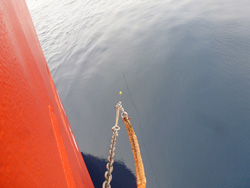Steve Lambert, WHOISeptember 2, 2012The Japan Agency for Marine-Earth Science and Technology (JAMSTEC), like many marine science groups, has deployed many moorings over the years. These moorings come in dozens of different configurations depending on scientific need, water depth, currents, budget, length of deployment and so on - some have been used with lots of small instruments or just a few large ones, some are deployed for months while others have been left for a year or two. Over the years moorings have evolved as mother nature has shown us what works and what doesn't. The mooring itself is usually pretty stable but keep in mind that by the time deployment day comes the equipment may have been shipped all over the globe, stored on a ship or in a warehouse or both, been dropped, damaged, frozen or baked in the blazing summer sun. And sometimes, once in a while, a mooring is lost. At the moment we are at about 76 degrees north and 175 degrees west which puts us due north of Russia. JAMSTEC deployed a mooring here a couple of years ago and last year an attempt was made to recover it but it didn't respond to any communications and with ship time being short it was left for another attempt. The JAMSTEC scientists came aboard the LSSL this year prepared to hunt for a non-responsive mooring. After recovering the first JAMSTEC mooring yesterday the team set out to communicate with this one again but after hours of no response a drag attempt was made. With the help of Senior Engineer Kevin Baker, Jonaotaro Onadera and Hirokatsu Uno built a large system of hooks with anchors, sinkers, and a couple of floatation spheres. This was attached to 2000 meters of used mooring cable and set over the side. Then the captain took the helm and the LSSL began to crawl astern at about 1.5 knots. The hope is that our large fishing rig would snag the mooring line and we could haul the entire unit aboard. But, after several hours of fishing, the team called it a day. I guess the fish just weren't biting today. Last night we had a costume party in the lounge. All the costumes were made from supplies found around the ship and I was really impressed with the imagination and work that went into them. There was a Portuguese Man-Of-War costume made from a haz-mat suit and garbage bags, a fish with salad bowl eyes, Sponge Bob and his pal Patrick were there, and a fish with scales made from water filters. We had a lot of fun! Last updated: October 7, 2019 | |||||||||||||||||
Copyright ©2007 Woods Hole Oceanographic Institution, All Rights Reserved, Privacy Policy. | |||||||||||||||||



